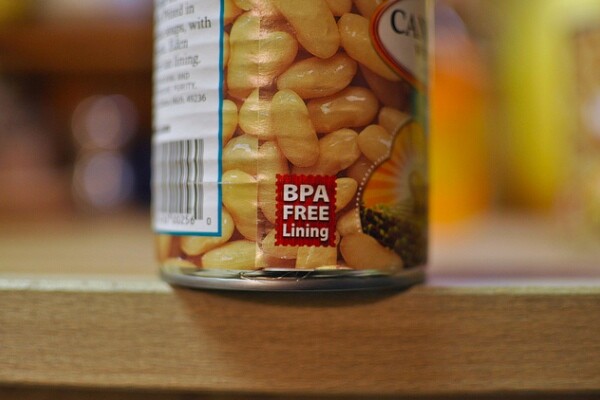The 4 Most Frightening Parts of the BPA-Free Expose

The investigative lengths that most of us go to when shopping for plastic water bottles can be summed up in two steps: (1) Find the marking on the bottle where it says "BPA-Free," (2) head on over to the register.
A whole lot of us are freaked out by BPAs, and for good reason. (More on this below.) But as this massive expose over at Mother Jones points out, the bottles with the marking confirming they don't contain BPA may not be any safer for us.
In fact, they may be more harmful.
The piece is important and worth reading. But also, it's very long. So, as a way to disseminate information to the more ADD among us, here are the four most important takeaways from it.
1. BPA is Worse For Your Grandkids Than You
Now, it's no surprise that BPA -- the chemical found in just about everything plastic -- is not exactly great for you. Study upon study has linked its usage to a wide range of health problems, from diabetes to reproductive issues to heart disease to asthma to, well, just about everything you can muster up.
The big problem with BPA is that it mimics estrogen, the compound that plays a huge role in a child's development. By having this extra bit of fake estrogen floating around, a child's physical and mental functions can be compromised. This is why people lost their collective minds over BPA-laden sippy cups and baby bottles, while mostly ignoring that adults are also constantly exposed to BPAs. Problem is, that thinking is short-sighted.
From the piece:
"A poison kills you," says biology professor Frederick vom Saal. "A chemical like BPA reprograms your cells and ends up causing a disease in your grandchild that kills him."
Which is to say: No, your kids aren't the only ones at risk. Your unborn descendants are as well.
2. BPA-Free Isn't Better
This is really the big thrust of the piece.
One of the most widely-used replacements to BPA is a polymer called Tritan, made by the Eastman Company. As this piece in The Atlantic from 2011 points out, the company released tests back in 2010 that were intended to show that the chemical leaves estrogen alone, unlike BPA, making this an acceptable replacement. However:
[N]o other environmental or toxicity information or the final product's other chemical ingredients is included.
Turns out, one of the chemical ingredients in Tritan -- the biggest part of it, in fact -- is something called triphenyl phosphate. And when that was tested for estrogen levels by Eastman, a finding that was never publicly disclosed, it tested for more estrogen than BPA. In short, BPA-free plastics may actually be worse for us than the ones with the dreaded BPAs.
3. Plastic Companies are Fighting Dirty
One need only glance at Eastman's official website for Tritan where the word "safe" comes at you from every angle in every font imaginable, to understand that they -- along with the rest of the plastics industry -- have millions and millions (and millions) of reasons to disprove and discredit any health concerns over the use of their products.
We've already seen this kind of thing with the shadowy fight waged by pro-BPA forces over the years: On the more benign side, creating and promoting a website that intentionally misleads people Googling for the harmful effects of BPA; on the more insidious side, using tactics straight out of the ongoing fight with Big Tobacco:
[I]n many cases, the plastics and chemical industries have relied on the same scientists and consultants who defended Big Tobacco.
In other words, they're trying to put up as many roadblocks as possible to prolong their business. And the stalling tactics work. The first studies looking at the unhealthy possibilites of BPAs started way back in 1987. But it wasn't until 2008 when the first wave of panic surfaced in the mainstream media, and 2012 when the FDA finally banned a portion of BPA-laden items.
Which is to say, the inevitable approaching fight over BPA-free plastics is going to be a long one, and that's due to the plastic companies doing everything they can to slow down the process. It makes sense from a budgetary standpoint: The net cost of putting easily manipulated scientists and consultants on the payroll is less than the profits they're getting from plastic sales.
4. The Government's Standards Are Way Off
Even without the plastic industry's meddling, the process may take quite awhile, seeing as the government has a backwards way of doing things.
After the big BPA scare, companies scrambled to come up with alternative plastics consumers wouldn't be scared of purchasing. So they put together some chemicals from the non-BPA bin in the lab, stamped them heavily with "BPA-Free" markings, and sent them out into the marketplace. And they did it all without running any safety tests on the products:
Nor did they have to: Under US law, chemicals are presumed safe until proven otherwise, and companies are rarely required to collect or disclose chemical-safety data.
In essence, because of how the laws are written, consumers become unwilling and unaware participants in a round of post-release experiments to test the safety of the chemicals. And that's not just BPA or BPA-free plastics. That's all chemicals.
So, if you're in the mood for some nightmare fuel, head on over to the Mother Jones piece -- here, I'll link it again, it's that good -- and then lock the door, bar the window, huddle down in the corner of the room with a blanket over your head, and try to get some sleep.


